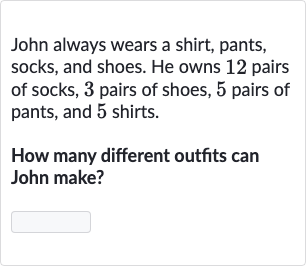Full solution
Q. John always wears a shirt, pants, socks, and shoes. He owns pairs of socks, pairs of shoes, pairs of pants, and shirts.How many different outfits can John make?
- Socks Choices: John has pairs of socks. So, he can choose from different socks.
- Shoes Choices: He owns pairs of shoes, which means he has choices for shoes.
- Pants Choices: For pants, he's got pairs, so that's options for the pants.
- Shirts Choices: And he's got shirts, giving him choices for shirts.
- Total Outfit Options: To find the total number of different outfits, we multiply the number of choices for each item of clothing.So, it's socks shoes pants shirts.
- Calculation: Now, let's do the math: .

